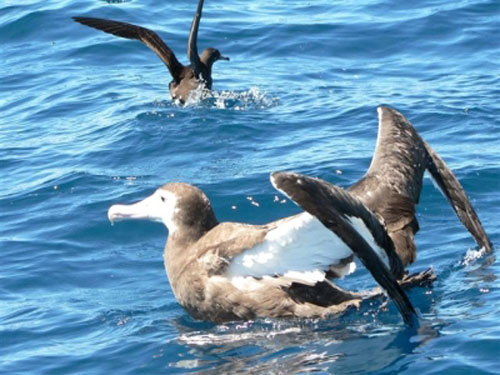David Grémillet, (CEFE-CNRS, Montpellier, France,) and colleagues writing in the open-access journal PloS ONE have looked at the high acidity level in Wandering Albatross Diomedea exulans stomachs which allow them to digest their prey quickly.
The paper's abstract follows:
"Animals are primarily limited by their capacity to acquire food, yet digestive performance also conditions energy acquisition, and ultimately fitness. Optimal foraging theory predicts that organisms feeding on patchy resources should maximize their food loads within each patch, and should digest these loads quickly to minimize travelling costs between food patches. We tested the prediction of high digestive performance in wandering albatrosses, which can ingest prey of up to 3 kg, and feed on highly dispersed food resources across the southern ocean. GPS-tracking of 40 wandering albatrosses from the Crozet archipelago during the incubation phase confirmed foraging movements of between 475-4705 km, which give birds access to a variety of prey, including fishery wastes. Moreover, using miniaturized, autonomous data recorders placed in the stomach of three birds, we performed the first-ever measurements of gastric pH and temperature in procellariformes [sic]. These revealed surprisingly low pH levels (average 1.50±0.13), markedly lower than in other seabirds, and comparable to those of vultures feeding on carrion. Such low stomach pH gives wandering albatrosses a strategic advantage since it allows them a rapid chemical breakdown of ingested food and therefore a rapid digestion. This is useful for feeding on patchy, natural prey, but also on fishery wastes, which might be an important additional food resource for wandering albatrosses."

Reference:
Grémillet, D., Prudor, A., le Maho, Y. & Weimerskirch, W. 2012. Vultures of the seas: hyperacidic stomachs in Wandering Albatrosses as an adaptation to dispersed food resources, including fishery wastes. PloS ONE 7(6): e37834. doi:10.1371/journal.pone.0037834.
(PLoS ONE is published by the Public Library of Science)
John Cooper, ACAP Information Officer, 22 June 2012

 English
English  Français
Français  Español
Español